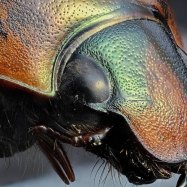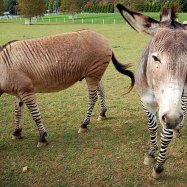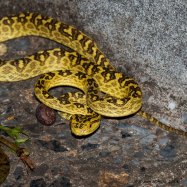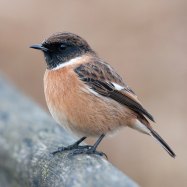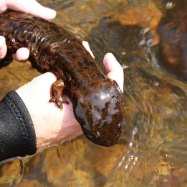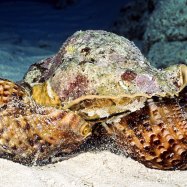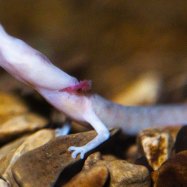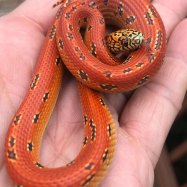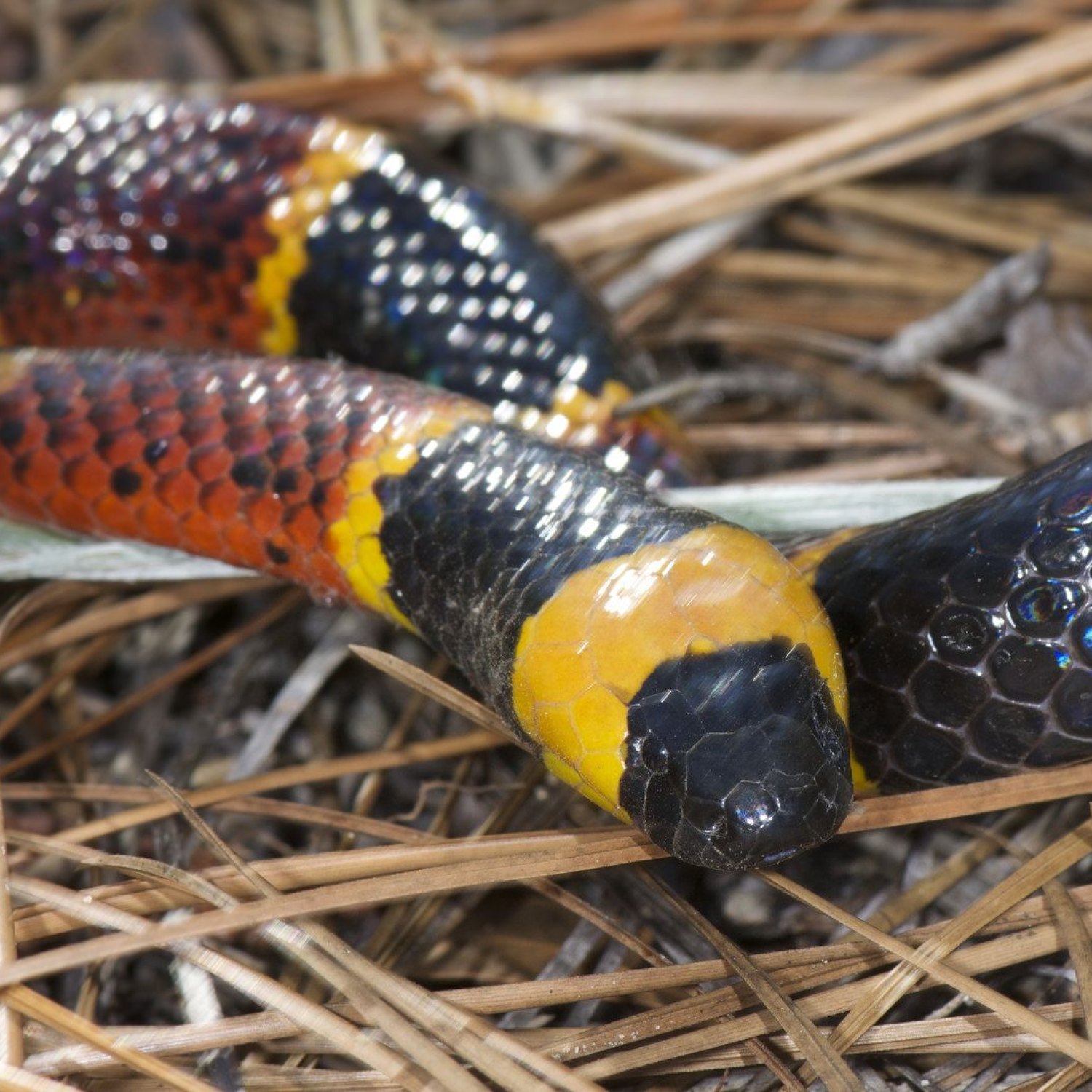
Eastern Coral Snake
20-48 inches
The Eastern Coral Snake is a stunning reptile found in the East and South of the US. It can grow up to 48 inches long and belongs to the Elapidae family. With its slender and cylindrical body, it's easily identified by its distinct red, yellow, and black stripes. Keep an eye out for this elusive beauty while hiking or exploring the outdoors. #EasternCoralSnake #USreptiles #Elapidae
Animal Details Summary:
Common Name: Eastern Coral Snake
Kingdom: Animalia
Habitat: Forests, swamps, marshes, and coastal areas
The Eastern Coral Snake: A Deadly Beauty of the Southeastern United States
The southeastern United States is home to a variety of unique wildlife, from alligators and bald eagles to armadillos and fireflies. But there is one species that stands out among the rest, both in its striking appearance and its notorious venom. This is the Eastern Coral Snake, also known as Micrurus fulvius.At about 20-48 inches in length, the Eastern Coral Snake may seem small compared to other reptiles Eastern Coral Snake. But do not let its size fool you - this snake packs a powerful punch. Its venom is a potent neurotoxin that affects the nervous system, causing respiratory failure and ultimately leading to death if left untreated.
Despite its deadly reputation, the Eastern Coral Snake is a fascinating creature that has captivated the minds of many. Let's take a closer look at this beautiful yet dangerous member of the animal kingdom.
Classification and Distribution
The Eastern Coral Snake belongs to the scientific classification Micrurus fulvius, which is derived from the Greek words "mikros" meaning small, "oura" meaning tail, and "fulvius" meaning tawny. It is a member of the phylum Chordata, class Reptilia, and order Squamata. It belongs to the family Elapidae, also known as the “true cobras”, which includes other venomous snakes such as the king cobra and the black mamba.The Eastern Coral Snake is found primarily in the southeastern region of the United States, with its range stretching from Florida to Georgia and the Carolinas. It prefers to inhabit forests, swamps, marshes, and coastal areas, as these environments provide ample hiding places and food sources English Cocker Spaniel.
Distinctive Appearance
The Eastern Coral Snake's beauty is undeniable. It is known for its distinctive red, yellow, and black banding, which gives it an almost mesmerizing appearance. These bright colors serve as a warning to potential predators that this snake is dangerous and should be avoided.However, the old saying, "Red on black, venom lack. Red on yellow, dangerous fellow" is not a reliable method of identifying venomous snakes. The coral snake, which has a red band next to a yellow band, has the same venomous potential as the Eastern Coral Snake. Its close resemblance to the harmless scarlet kingsnake, which has a similar color pattern but with red touching black, has led to many cases of mistaken identity and unnecessary deaths.
One way to tell the difference between the two is to look at the order of the bands. The Eastern Coral Snake’s bands follow the color pattern of red, yellow, black, while the scarlet kingsnake has the order of red, black, yellow.
Diet and Feeding
Like most snakes, the Eastern Coral Snake is a carnivore. Its diet consists mainly of other snakes, such as the copperhead and the cottonmouth, but it also preys on small mammals, lizards, and frogs. It uses its powerful venom to immobilize its prey, making it easier to swallow. Interestingly, the Eastern Coral Snake is immune to its own venom, making it possible for them to eat other coral snakes without any ill effects.Despite their deadly reputation, the chances of encountering an Eastern Coral Snake in the wild and being bitten are incredibly low. These elusive creatures are shy and usually avoid humans, hiding in leaves or underground burrows. They only strike if they feel threatened, such as when stepped on or handled.
Threats and Conservation
The Eastern Coral Snake may be feared by many, but their greatest threat lies in the loss of their natural habitat. Due to urbanization and deforestation, these snakes are losing their homes and food sources, forcing them into more dangerous territories where they are more likely to encounter humans. As a result, the Eastern Coral Snake is now listed as a species of concern in the United States and is protected from hunting and other harmful activities.However, another threat to this species is the illegal pet trade. Many people are drawn to the Eastern Coral Snake’s beauty and may attempt to capture them as exotic pets. This is not only harmful to the snakes but also poses a risk to the owners and those around them.
Final Thoughts
The Eastern Coral Snake is undoubtedly a deadly beauty, captivating and terrifying all at once. Its striking appearance and potent venom make it a subject of fascination and fear. However, as with all animals, it is important to respect these creatures and avoid any unnecessary contact with them.In the end, the Eastern Coral Snake is a vital part of the ecosystem and a reminder of the delicate balance of nature. Let us strive to preserve and protect their habitats, ensuring that this unique species continues to thrive for generations to come.

Eastern Coral Snake
Animal Details Eastern Coral Snake - Scientific Name: Micrurus fulvius
- Category: Animals E
- Scientific Name: Micrurus fulvius
- Common Name: Eastern Coral Snake
- Kingdom: Animalia
- Phylum: Chordata
- Class: Reptilia
- Order: Squamata
- Family: Elapidae
- Habitat: Forests, swamps, marshes, and coastal areas
- Feeding Method: Carnivorous
- Geographical Distribution: Southeastern United States
- Country of Origin: United States
- Location: Eastern and Southern United States, primarily in Florida, Georgia, and the Carolinas
- Animal Coloration: Distinctive red, yellow, black banding
- Body Shape: Slender and cylindrical
- Length: 20-48 inches
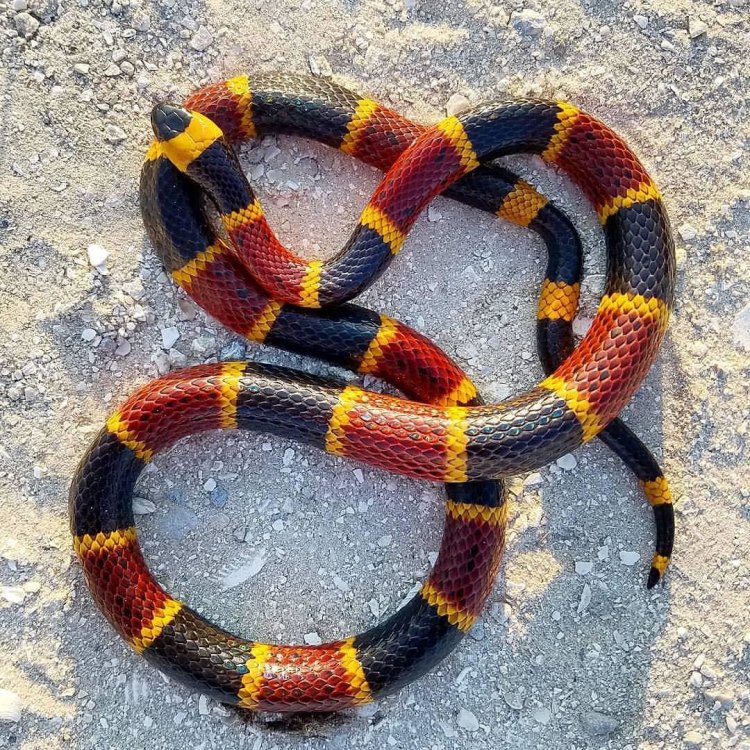
Eastern Coral Snake
- Adult Size: 40-60 inches
- Average Lifespan: 5-10 years
- Reproduction: Sexual
- Reproductive Behavior: Mate in the spring and lay eggs in the summer
- Sound or Call: No known vocalizations
- Migration Pattern: Non-migratory
- Social Groups: Solitary
- Behavior: Mostly nocturnal
- Threats: Habitat loss, human persecution, and road mortality
- Conservation Status: Least Concern
- Impact on Ecosystem: Help control rodent populations
- Human Use: Not used by humans
- Distinctive Features: Brightly colored banding
- Interesting Facts: Eastern coral snakes have powerful venom but are shy and rarely bite humans. They have a unique way of delivering venom through their fixed fangs located in the back of their mouths, requiring the victim to be chewed on for the venom to be injected.
- Predator: Predators of Eastern coral snakes include some species of kingsnakes and ravens.
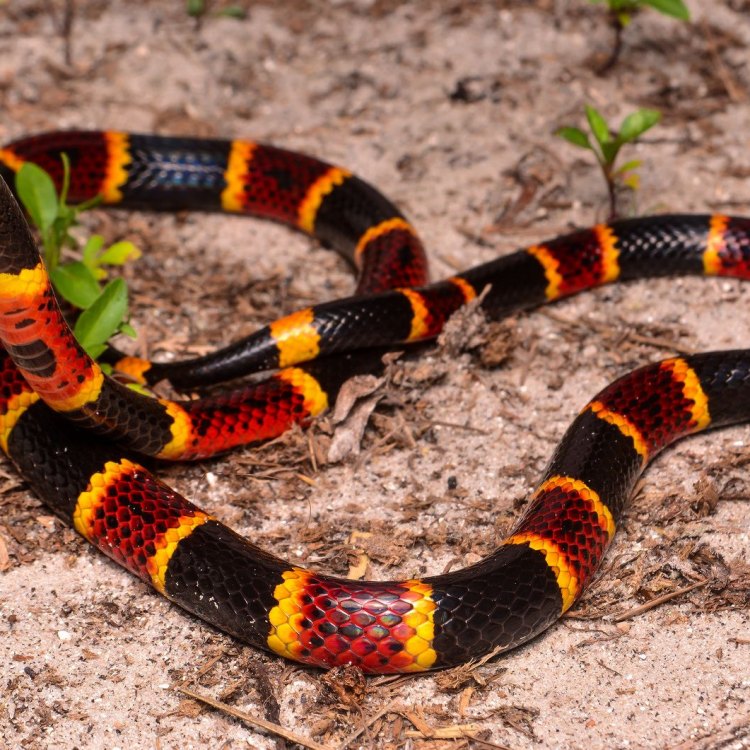
Micrurus fulvius
The Enigmatic and Colorful Eastern Coral Snake
Hidden among the leaf litter of the southeastern United States lies a creature that is both feared and misunderstood - the Eastern coral snake. With its distinctive red, yellow, and black banding, this beautiful snake has captured the imaginations of many, but few truly understand its unique features and role in the ecosystem. In this article, we will delve into the mysterious world of the Eastern coral snake, exploring its physical attributes, behaviors, and impact on the environment.Size and Lifespan
Measuring between 40-60 inches, the Eastern coral snake is a relatively small snake compared to other species found in the United States PeaceOfAnimals.Com. However, its small size does not make it any less fearsome. With an average lifespan of 5-10 years, this member of the Elapidae family has plenty of time to carve out its place in the ecosystem.
Reproduction and Behavior
As with most snakes, the Eastern coral snake reproduces sexually. Mating typically occurs in the spring, with females laying eggs in the summer. However, unlike many other snake species, Eastern coral snakes are solitary creatures and do not form social groups. They are mostly nocturnal, preferring to hunt and explore under the cover of darkness.
Communication and Predators
Interestingly, the Eastern coral snake does not have any known vocalizations or calls. Instead, they rely on their distinctive coloration to communicate with other animals. The bright banding on their bodies serves as a warning to potential predators, signaling that they are highly venomous Eastern Barred Bandicoot.
Speaking of predators, the Eastern coral snake has a few natural enemies in the wild. Some species of kingsnakes and ravens are known to feed on these snakes, making them important pieces in the intricate puzzle of the food chain.
Distinctive Features
The Eastern coral snake's most well-known feature is undoubtedly its bright coloration. The red, yellow, and black banding on its body serves as a warning to potential predators. But these vibrant colors also serve another purpose - camouflage. When slithering through the leaf litter, the Eastern coral snake's banding helps it blend in seamlessly, making it challenging to spot for both predators and prey.
Another unique feature of the Eastern coral snake is its venom delivery system. While most venomous snakes have hollow fangs that inject venom into their victim's bloodstream, the Eastern coral snake has a different approach. Its fangs are fixed and located in the back of its mouth, requiring the victim to be chewed on for the venom to be injected. This makes it a notoriously difficult snake to milk for anti-venom production, further adding to its enigmatic nature.
Threats and Conservation Status
Like many other species in the world, the Eastern coral snake faces numerous threats to its existence. Habitat loss, human persecution, and road mortality are some of the primary threats to these snakes. As human development and urbanization continue to encroach on their habitat, their population numbers continue to decline.
Despite these threats, the Eastern coral snake is currently listed as "Least Concern" on the International Union for Conservation of Nature's (IUCN) Red List. However, this does not mean that we should turn a blind eye to their conservation. Every species has a vital role to play in the ecosystem, and the Eastern coral snake is no exception.
Impact on the Ecosystem
As with many other snakes, the Eastern coral snake plays a crucial role in the ecosystem. One of its main contributions is controlling rodent populations. These snakes are skilled hunters, and their diet primarily consists of small mammals, such as mice and voles. By keeping these populations in check, they help maintain the balance of the ecosystem.
Human Use
Unlike other snakes, the Eastern coral snake does not have any known uses for humans. They are not used for food, traditional medicine, or any other purpose. However, they do play a vital role in education and research, providing invaluable insights into the world of snakes, their behavior, and venom.
Interesting Facts
In addition to its unique features and impact on the ecosystem, the Eastern coral snake also has some interesting and curious facts surrounding it. Despite its powerful venom, these snakes are shy and rarely bite humans. In fact, there have only been a few reported human fatalities from Eastern coral snake bites. This is due to their reclusive nature, preferring to retreat rather than engage in confrontations.
In addition to their unique venom delivery system, Eastern coral snakes also have an interesting reproduction behavior. Unlike most snakes that lay eggs in burrows or nests, female Eastern coral snakes lay their eggs in moist soil or leaf litter and leave them to incubate on their own. This is also why it is rare to see Eastern coral snakes during the breeding season, as they prefer to stay hidden and protect their eggs.
Final Thoughts
The Eastern coral snake may be shy and elusive, but there is no denying the beauty and complexity of this species. With its brightly colored banding, unique venom delivery system, and vital role in the ecosystem, this snake is undoubtedly a fascinating creature. However, it is crucial to remember that they are wild animals and should be respected and left alone in their natural habitat. By understanding and appreciating these enigmatic snakes, we can work towards their conservation and ensure their continued presence in the wild for generations to come.
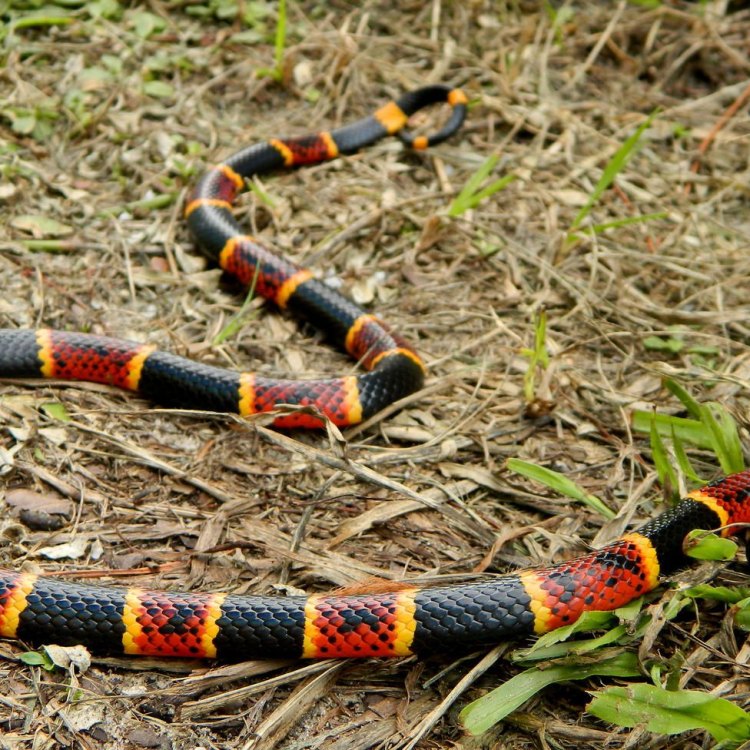
The Eastern Coral Snake: A Deadly Beauty of the Southeastern United States
Disclaimer: The content provided is for informational purposes only. We cannot guarantee the accuracy of the information on this page 100%. All information provided here may change without prior notice.

